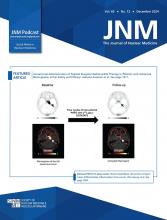In their editorial, “Feasibility of 177Lu-PSMA Administration as Outpatient Procedure for Prostate Cancer,” Zagni et al. (1) report on a first experience with an outpatient treatment scheme using 177Lu-PSMA, which they implemented at the University Hospital at Bologna, Italy.
This outpatient scheme has become possible with the implementation of the Council Directive 2013/59/Euratom (2) in new Italian legislation (Legislative Decree 101/2020 (3)) in 2020, which lifted the previous legal requirement to hospitalize, for at least 48 h, patients who receive a radiopharmaceutical treatment. This requirement persists only for therapies applying more than 600 MBq of 131I (3). The new Italian legislation exploits the margin of discretion that member states of the European Union have when transposing Council Directive 2013/59/Euratom (2) into national law, as the European Directive sets the minimum requirements (basic safety standards) for the member states. It also reflects the recommendations of other international bodies, such as the International Council on Radiation Protection (4,5) and the International Atomic Energy Agency (6), concerning individualized patient release and recognizes that 177Lu exhibits different radiologic properties from 131I, which has traditionally been mostly used. Legislative Decree 101/2020 (3) authorizes the medical doctor administering the radiopharmaceutical, the medical physics expert, and the local radiation protection expert to evaluate each case individually and to ensure compliance with the legal radiation protection requirements by adequate instructions to the patient and family. When geographic constraints, comorbidities, tumor burden, kidney function, or other patient-specific or household-specific circumstances do not contraindicate this approach, an outpatient administration of radiopharmaceutical therapies using 177Lu is now possible. Apart from the benefits to the patient and family, this approach enables a more efficient use of treatment capacities. Such gains in efficiency become critically important as the number of cancer patients for radiopharmaceutical therapies significantly grows in the coming years.
In March 2024, the Italian Association of Medical Physics and the Italian Association of Nuclear Medicine published a common document (7) to promote a consistent approach to patient release and to guide medical and radiation protection staff. The document demonstrates how to adhere to legal radiation protection requirements while implementing an outpatient scheme with a minimum 6-h hospitalization. Patients and family members are instructed about contact restrictions in terms of duration and distance, comprising rules for sick leave to minimize exposure of working colleagues and for accidental encounters with members of the public. The instructions take the accumulated exposure effects of several treatment cycles into account and require as input the physical half-life of the radionuclide, the biologic half-life of the radiopharmaceutical, and the applied dose (7). A final dose-rate measurement at a reference distance from the patient at the time of release, together with assumptions on contact patterns in terms of time and distance from the patient, is then used to calculate the duration of contact restrictions (8). The assumptions made for contact patterns appear rather conservative, and a more refined approach could be envisaged, which may lead to more realistic dose estimates for family members and caregivers. Such a refinement could become feasible on the basis of real-world exposure data. Appropriate data could be gathered by providing dosimeters to released patients and their family members. Such a study has recently been presented for 131I therapies (9), and 177Lu therapies should be investigated in the same way with high urgency, ideally in different countries to capture possible effects of cultural differences in contact patterns.
Of course, this newly gained flexibility comes with an increasing responsibility and workload for the administering medical and radiation protection staff. It is the merit of Zagni et al. (1) that they accept this responsibility and workload and use it for the benefit and the quality of life of their patients and to facilitate access of more patients to these new and promising radiopharmaceutical treatments.
DISCLOSURE
No potential conflict of interest relevant to this article was reported.
Footnotes
Published online Nov. 7, 2024.
- © 2024 by the Society of Nuclear Medicine and Molecular Imaging.
- Received for publication October 9, 2024.
- Accepted for publication October 15, 2024.







